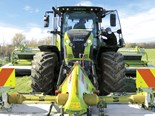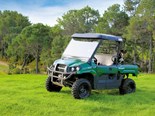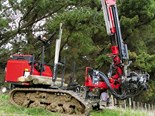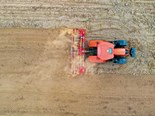Test: John Deere 8500 Forage Harvester
Farm Trader's Jaiden Drought along with his Aussie counterpart Harrison Hunkin tests the John Deere 8500 Forage Harvester
Forage harvesters are one those farm machines you could look at forever and still find things to appreciate.
 |
|
The automated trailer filling working well on truck bins
|
The sheer size alone begs further inspection. Often you hear diesel being turned into noise before you see them, and that’s before you begin to recognise the amount of technology the AG giants pump into them.
For this test-drive, which was incorporated as part of a video shoot for Mighty Machines, Farm Trader’s Jaiden Drought teamed up with his Aussie counterpart Harrison Hunkin to test the John Deere 8500 – one of the best on the market – at a maize block in the South Canterbury (P.S. If you haven’t seen Mighty Machines yet, then here’s your official invitation to take an afternoon off and binge-watch the entire series).
.jpg)
For the price of two Porsche sports cars, a farmer can get his hands on 600hp from a machine that easily dwarfs even a Hummer. Jaiden is quick to admit that he would much rather drive the chopper all day than get behind the wheel of a "pompous" sports car.
Engine
Back to the John Deere where we start with the power plant. The latest John Deere 8500 forager boasts a 13.5-litre John Deere Powertech engine. The Tier 2 compliant 8500 engine pushes out a hefty 577 ponies (horsepower), but to keep the masses happy, the 8000 series range offers eight different powered models between 375hp and 843hp.
Engine access and serviceability are a focus point of the 8000 series choppers. Easy-to-open access points are found at the rear and side panels. While this isn’t a unique feature of John Deere, the access latches are at a useful height making the chore that little bit more convenient.
John Deere says the machine will benefit from fuel savings if equipped with the ProDrive system, which essentially shifts between ranges as ground conditions change, keeping the machines harvesting at the "optimum" speed.
Cab
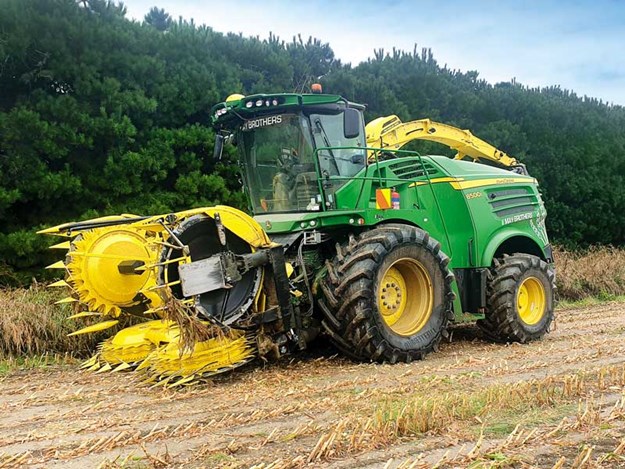 |
|
The eight row maize front folds neatly for transport while still allowing good visibility from the cab
|
Inside the 8500 is similar to that of its combine cousins. So if you’re acquainted with the John Deere combine range, then you’ll feel right at home inside, as the 8500 features familiar functions such as the A-pillar display and command arm console.
It’s a four-pillar cab so it’s comfortable with great visibility front and the rear. The new curved and tilted windscreen has an anti-glare feature designed to minimise reflections, giving you clear visibility of the crop and header at night and in rainy conditions. Inside, you’ll find the multi-function ‘hydro handle’ joystick does everything from driving, loading, cutting to feedroll engagement.
 |
|
The new curved and tilted windscreen has an anti-glare feature
|
Jaiden and Harrison rarely agree when it comes to machinery, but they are united in stating that this is a machine you would feel comfortable being in for long days, which is a key feature for a forager (along with cutting ability and a host of other pre-requisites).
In terms of the nerdy gear inside, there’s automatic air con and Bluetooth connectivity (which provides hands-free calling and music playback), all selected from the right CommandArm console so you aren’t ferreting around above your head to change a song; particularly handy for Harrison who is partial to a bit of Billy Ray Cyrus.
While every manufacturer claims they have the most ‘ergonomic’ armrest (it must be the buzzword for ag manufacturers at the moment), the John Deere 8500 really is convenient. Everything is laid out in intelligent locations at an arm’s length. The only small gripe is the ‘hot’ keys are all the same (apart from the different letter), so until you’re familiar, it can be difficult to remember which hot key does what.
Feeding/crop flow
The crop flow path in the John Deere 8000 series has been totally redesigned, with an intent to improve throughput, chop quality, and reduce fuel consumption, all of which is music to harvester owners’ ears. The 8500’s springs, bearings, and components have been upgraded for better performance and reliability to handle greater horsepower.
The 8500 also has a 25% wider feedroll opening compared with the 7000 series choppers, while the reliable DuraDrum is back and has a 10% bigger drum diameter.
If corn cutting is what you are after, the KP (kernel processor) can be switched in and out in under five minutes, thanks to the location (behind the front axle) and easily accessed from in the service area behind the cab.
HarvestLab 3000
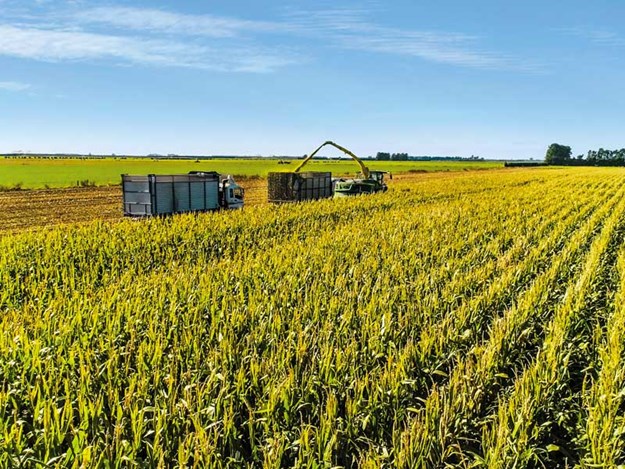 |
|
The HarvestLab 3000 moisture sensor collects real-time readings of the crop
|
High-quality silage is obviously a must for both the farmer and the contractor chopping the product. So, fitted at the base of the spout, just behind the cab, is the HarvestLab 3000 moisture sensor. This technology has obviously been around for a while, but it still impresses me to know that the machine collects real-time readings of the crop.
Readings aren’t affected by the elements because the HarvestLab 3000 moisture levels are measured 10 times per second using Near-Infrared Technology (NIR), which is some serious in-depth technology. This info allows contractors or farmers the ability to select the best chop length, optimum inoculant application rate, and feed analysis of crop harvested.
HarvestLab 3000 is factory calibrated and comparison of data from the chopper can be compared with the weighbridge to give the operators a real-time product snapshot.
Active Fill Control
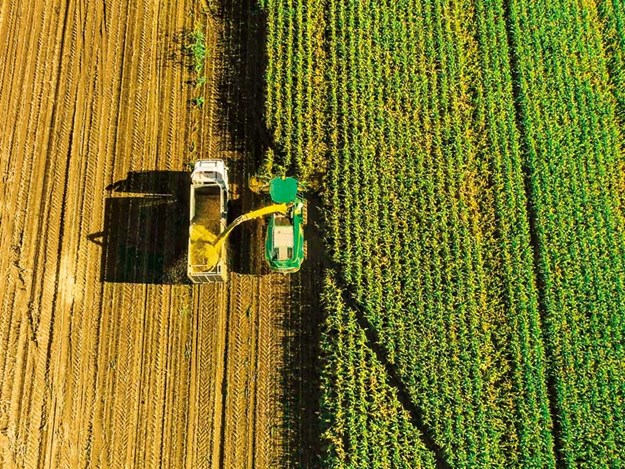 |
|
Active Fill Control uses a 3D camera for spout tracking to fill the truck bins
|
Apart from the plush comfortable cab with easy-to-reach controls, there are two more features that essentially drive the chopper itself; all you need to do is set the forward speed.
The first is Active Fill Control. This is pretty much what it says on the tin. It creates a border around the truck or trailer and then uses a 3D camera to fill in the way you have selected, e.g. front to back, back to front, inside the driver’s window, etc.
Once the bins are loaded into the system, the camera detects it and automatically begins tracking with the spout. Then it controls the rotation and cap position of the spout until the truck is filled.
While this does work well on trucks and lower bin trailers, loading into loader wagons is a little less accurate due to the height of the trailers where the camera can’t get a full ‘bird’s-eye view’ of the wagon’s exterior.
Starfire 6000 GPS
 |
|
A bird’s-eye view of the John Deere in action
|
This is the second feature, and in terms of efficiency is where the most gains are made in the chopper driving itself. May Brothers (the choppers owners) run a fleet of John Deere tractors so the Auto Track settings from the planter tractor are uploaded into the chopper, and bingo, no overlap, no missed rows, nothing; just eight rows constantly being pulled into the Kemper maize front. This accuracy in the Starfire 6000 is down to 2.5cm without a base station.
Verdict
 |
|
Farm Trader’s Jaiden Drought loves nothing more than getting behind the wheel of big machines like this
|
Overall, the 8500 is a reliable, well-made machine. Yes, the new 9000 series foragers are out and about the world, but for most of New Zealand and Australian requirements, the 8000 series machines are more than adequate.
While Harrison and I have managed to get seat time on some pretty impressive machinery, we straight up agree that this is one of our favourite machines featured on Mighty Machines.
The features and performance of the 8000 series have given operators the ability to run a full green fleet. And the advantages of this include staff familiarity and technology advantages like that of the Starfire 6000, giving John Deere the tools to really have a crack at a decent chunk of the forager market.
John Deere 8500 forage harvester specifications
| Engine power | 400 kW@2100 rpm |
|
Cutterhead housing width |
685.5mm |
|
Length of cut with 40 knives |
7–26 mm in 1mm steps |
| Length of cut with 48 knives | 6–22 mm in 1mm steps |
| Rear tyres | 710/60 R30 |
| Front tyres | 900/60 R42 |
| Min pick-up width | 2.55m |
| Max pick-up width | 3m |
| Travel speed | 40km/h max speed |
| Transport length | 6.6m |
| Transport width | 3.7m |
| Transport height | 3.89m |
| No of cylinders | 6 |
| Emission level | Tier 2 |
Pluses
- Extremely comfortable and quiet cab
- Auto track and auto fill means the chopper almost does everything for you
- Easy access, thanks to high-lift side panels
- The new Kemper maize head can also be used as a whole crop head meaning less initial investment
- Increase in drum size, number of knives, and crop flow give significant increase in output over previous 7080 series
- Knives are sharpened in reverse with auto shear bar adjustment, all in less than one minute
- Well-laid-out controls made the machine a pleasure to drive
- Plenty of tool storage in the swing out toolbox located in the rear bumper of the machine
- Large number of lights for when the candle is being burnt from both ends
Minuses
- Auto fill system wasn’t fool proof; worked well on trucks but not so well on higher loader wagons
Find more forage harvesters for sale in NZ
Keep up to date in the industry by signing up to Farm Trader's free newsletter or liking us on Facebook




.jpg)





